What is Source Water Protection? Source water protection is the protection of all present and potential future drinking water sources including ground water protection, wellhead protection, aquifer protection, and watershed protection pertaining to drinking water sources.
Partnering to Protect Drinking Water Sources: Source water protection is all about collaboration. State and federal agencies and programs, drinking water utilities, nonprofit organizations, communities, landowners, and many other stakeholders can all work together to help protect drinking water sources on the ground at the local level. Public and private assistance and funding programs are available to help partners implement voluntary protection efforts throughout the US.
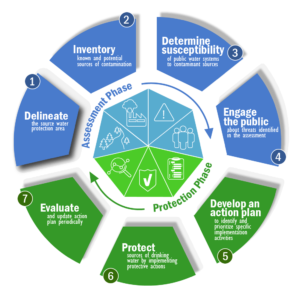
Graphic Source: U.S. EPA SWP Website
Source Water Assessments: The 1996 Amendments to the Safe Drinking Water Act required every state to develop a Source Water Assessment and Protection Program (SWAP) and conduct source water assessments for all public water systems. States and water utilities have made great strides to update many of these assessments since they were originally due in 2003. The assessments include:
- Delineation of source water protection (SWP) areas with maps of the surface water or wellhead protection areas.
- Inventory (and mapping) of potential sources of contamination within the SWP areas.
- Vulnerability/susceptibility analyses that considers the risk for each of the potential contaminants to impact the drinking water source.
- Public participation & public access to the assessment results and threats to drinking water.
Source Water Protection Planning and Implementation: Source water protection is primarily a voluntary activity that includes planning and implementation of actions to protect drinking water sources from contamination. Protection includes:
- Developing an action plan to identify and prioritize implementation activities.
- Implementing protective actions to protect sources of drinking water (e.g., collaboration, monitoring, best management practices, conservation, mitigation, spill response, education).
- Periodically evaluating and updating the action plan.
ASDWA Initiatives for Agriculture and Forestry Collaboration
Report and Fact Sheets from ASDWA and GWPC: The February 2023 fact sheet and September 2021 report and fact sheet continues our collective efforts to share information about the accomplishments of state source water protection (SWP) programs in coordination with the USDA Natural Resources Conservation Service (NRCS), state foresters, the US Forest Service (USFS) and other partners, as well as challenges and tips for success with state examples of potential solutions for making further progress.
- February 2023
- September 2021
Collaboration Opportunities – Together, agriculture, forestry & drinking water programs can:
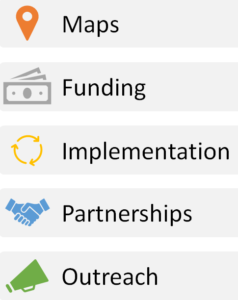
- Share maps, water data, and information on ag & forest lands and drinking water (surface and ground water) protection areas.
- Provide information and leverage potential funding sources (NRCS, state DWSRF and 319, public and private grant programs).
- Assist with implementation and help target state agricultural and forestry initiatives and practices to protect drinking water sources.
- Work in partnership with federal and other state agencies, local governments, drinking water utilities, and nonprofits.
- Share information and conduct outreach to communities and landowners.
Contact Information: Opportunity to Act Now!
- Reach out to your state source water protection coordinator at www.asdwa.org/sourcewatercontacts
- Reach out to your NRCS State Conservationists Office
- Reach out to your state SFAP revision contact at Northeast & Midwest States, Western States & Southern States.
- Reach out to your US Forest Service Regions and Districts
Agriculture: State Source Water Protection Programs can work with their NRCS State Conservationist’s office, Conservation Districts, and other partners to implement agricultural conservation and practices that protect drinking water sources.
- Source Water Protection in the 2018 Farm Bill
- Emphasizes source water protection through all Farm Bill conservation programs
- Directs 10% of NRCS conservation funding for source water protection, equaling a total of $4 billion over the next 10 years
- Authorizes NRCS State Technical Committees to work with water utilities to identify priority areas in each state
- Provides additional incentives for farmers who employ practices that benefit source waters
- ASDWA Handout on State SWP Coordination with NRCS – July 2020: This handout shares information about how states and NRCS are working together to select high priority areas and target agricultural and forestry practices with landowners to protect drinking water sources.
- Source Water Collaborative Toolkit: Toolkit with simple steps for working with NRCS State Conservationists and Conservation Districts.
- NRCS Conservation Programs: The NRCS website provides information about each of the NRCS programs for funding landowners to implement practices that can be used to protect drinking water sources.
- NRCS Source Water Protection Website with National Priority Area Map
Forestry: State Source Water Protection Programs can work with their State Forester’s office, the U.S. Forest Service (USFS), and other partners on prioritizing forested lands for source water protection activities and projects.
- State Forest Action Plans (SFAPs): Each state has an SFAP that assesses all forested lands – public, private, rural, and urban – and sets priorities (that can include drinking water) for stewardship funding and technical assistance. They are updated every five years and rewritten every ten years, with the current timeline of completion set for June 2020.
- NASF Memo to SFAP Leaders (3/30/20): ASDWA worked with a few members of the National Source Water Collaborative to develop this memo for the National Association of State Foresters (NASF) that was emailed to the SFAP leads in each state to encourage them to include drinking water in their SFAPs. The memo has many references to SFAPs that already include drinking water as examples for other states.
- SFAP Examples:
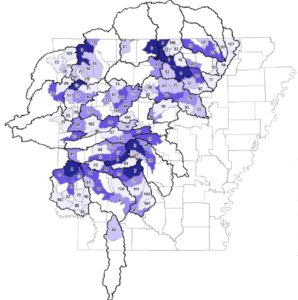
Arkansas priority forested drinking water watersheds
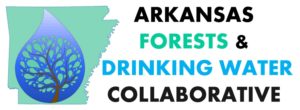 Arkansas Forests & Drinking Water Collaborative: State handout on how partners are working together and used GIS analysis to prioritize forested watersheds for drinking water protection. Drinking water is included in all of the Arkansas SFAP publications (SFAP Assessment, Strategy & Priorities). The 2020 Fact Sheet Key Issues first bullet focuses on drinking water: “Land use changes and development continue to complicate forest management considerations. Maintaining healthy watersheds is a priority to protect drinking water quality.”
Arkansas Forests & Drinking Water Collaborative: State handout on how partners are working together and used GIS analysis to prioritize forested watersheds for drinking water protection. Drinking water is included in all of the Arkansas SFAP publications (SFAP Assessment, Strategy & Priorities). The 2020 Fact Sheet Key Issues first bullet focuses on drinking water: “Land use changes and development continue to complicate forest management considerations. Maintaining healthy watersheds is a priority to protect drinking water quality.”
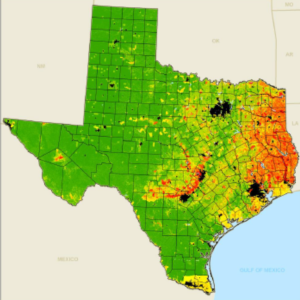 Texas Forests & Drinking Water Partnership: Formed in 2015 with state and federal agencies, water utilities and forest owners to enhance drinking water, forest lands, and local economies. Drinking water is included in the Texas SFAP Forest Resource Strategy: Issue 4 on Water Resources (starting on page 16) goals and strategies.
Texas Forests & Drinking Water Partnership: Formed in 2015 with state and federal agencies, water utilities and forest owners to enhance drinking water, forest lands, and local economies. Drinking water is included in the Texas SFAP Forest Resource Strategy: Issue 4 on Water Resources (starting on page 16) goals and strategies.
-
- Missouri: The Missouri 2010 SFAP, Issue 4 “Maintaining High Quality Soil and Water Resources” (on pages 55-60) includes drinking water in the desired future conditions, the role of trees and forests, a map assessment and BMPs.
- Minnesota: The Minnesota Forests and Drinking Water Evaluation is based on Principle 9 of the 2015 Forest Stewardship Council Standard for identifying, mapping, management, and monitoring the high conservation value (HCV-4 for critical ecosystem services) of forests related to community groundwater and surface water drinking water sources.
- Drinking Water Providers Partnership in Oregon and Washington State is a collaboration of federal, state, and NGO partners that coordinate an annual competitive grant and award program for environmental (and forest) conservation and restoration in municipal watersheds.
US Forest Service Resources
- Forests to Faucets: This GIS tool maps the forest lands in the continental US based on their importance to surface water drinking water, the role forests play in protecting these areas, and the extent to which these forests are threatened by development, insects and disease, and wildland fire.
- Northeast Midwest (NEMW) Guide for State Forest Action Plans (August 2018) and checklist: Watershed Forestry (on Page 23) includes “source water protection” in the SFAP elements and strategies for “conservation.” The related US Forest Service Report used GIS maps to identify priority forested watersheds for drinking water supply.
- Forests and Water: Helping to Meet the South’s Water Needs Today and Tomorrow: Brochure by the USFS R&D Southern Research Station that highlights the importance of forested watersheds in protecting water quality.
- USFS Guide to Watershed Investment Partnerships: For building source water protection partnerships for funding.
Other Forestry Resources
- Southeastern Partnership for Forests and Water: This group helped establish the Texas and Arkansas forums and works with other SE states to strengthen partnerships and identify priority watersheds and projects for funding.
- Videos on forests and source water protection: Produced by the Southern Group of State Foresters and the Southeastern Partnership for Forests and Water.
- US Endowment for Forestry and Communities: This organization works with public and private partners (including the US Forest Service and water utilities) to advance sustainable efforts and funding vehicles for healthy forests and forest-reliant communities to achieve social, ecological, and economic benefits.
- Forest Cover Impacts on Drinking Water Utility Treatment Costs in a Large Watershed: 2018 Water Research Foundation project report.
Resources
Source Water Collaborative Webinar: Updates From NRCS and The Northeast: Partnering To Protect Drinking Water (June 2020): This webinar included information about the new NRCS Bulletin on selecting priority source water protection areas in each state. View the webinar recording here.
ASDWA Webinars on the USDA NRCS National Water Quality Initiative (NWQI)
- ASDWA Webinar Recording – April 30, 2020: What’s New with NRCS National Water Quality Initiative (NWQI) this Year?
- USDA NRCS NWQI Webinar – Aug 1, 2018 – Intro
- USDA NRCS NWQI Webinar – Aug 1, 2018 – Main Slide Deck
- Webinar Video Recording – Aug 1, 2018
ASDWA – GWPC Groundwater-Based Source Water Protection Paper (September 2019): This paper is a great educational handout for state drinking water and groundwater programs, as well as water utilities and other water quality stakeholders, to share with potential partners when talking about the importance of, and special considerations for, protecting groundwater sources of drinking water.
EPA Source Water Protection Website: Includes basic information about source water protection, describes components of a source water protection program, and highlights new opportunities for funding and partnerships.
EPA SWP Funding and FITS Tool: The FITS tool explains how users can integrate various federal funding sources for activities that protect sources of drinking water.
AWWA SWP Website: Includes a whiteboard video that describes 2018 Farm Bill provisions and agricultural practices protect drinking water sources, a performance metrics tool, a justification toolkit, and other resources.
The Source Water Collaborative is comprised of 30 partners from Federal, state, and local agencies and organizations (including ASDWA) that work together, as well as individually with their constituents, to help policymakers, planners, agricultural interests, developers, citizen groups, and others integrate source water protection into key decision-making processes. Visit the web site to:
- Find out more about the Learning Exchange – a platform to share experiences, transfer knowledge, and learn about funding and technical resources.
- Download/Print the Call to Action and the associated Resources Document with key actions for state, federal, and local partners to: update and improve source water assessments and protection plans; protect drinking water sources and work with key partners; and implement rapid emergency notification and response procedures and see tools and examples in the resources document to support the key actions.
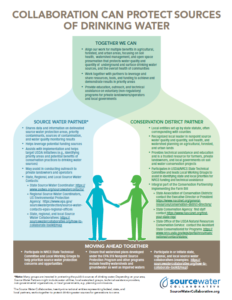
- Use the Toolkits for:
- Download/Print the Your Water Your Decision Guide for local officials.
- Contact allies to partner with in your state or local area.
- Download/Print the local land use Planners Guide to help them protect drinking water sources.





